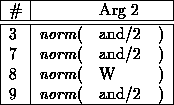



Next: Allowing Variables in
Up: Using More Than
Previous: Depth Oriented (MDN)

The following algorithm (MN-Algorithm) combines the MNB- and
MND-Algorithms:
- For each argument column
 , create a list
, create a list  where
where  is the longest prefix of column
is the longest prefix of column  without variables
without variables
- If
 then use the first clause as a
separate partition (without indexing) else
then use the first clause as a
separate partition (without indexing) else
- sort the
 in descending order (w.r.t. their length)
into the list
in descending order (w.r.t. their length)
into the list 
-
 := length of first element in
:= length of first element in 
-
 := position of last column in
:= position of last column in  with length
with length
 with
with  (this means
that in order to enlarge the index tree breadth the partition
size may be reduced, e.g. by at most 30%
(this means
that in order to enlarge the index tree breadth the partition
size may be reduced, e.g. by at most 30% )
) ;
;
 := length of this column;
:= length of this column;
 first
first  elements of
elements of  ;
;
reorder  w.r.t. selectivity
w.r.t. selectivity
- create a partition consisting of the first
 clauses;
index the argument columns in
clauses;
index the argument columns in  (
( index tree breadth)
index tree breadth)
- for each constant/functor occurring multiply in one
argument column of this partition do
- form a procedure containing all selected clauses
and the remaining argument columns in
 (only columns to the right of the current one)
(only columns to the right of the current one)
- apply the MN-Algorithm recursively to this procedure
(
 index tree depth)
index tree depth)
- If any clauses are left go to 1 else stop
MN-Algorithm applied to norm example:
-
-

- use clause 1 as first partition
-
-

-

-

-

-
 (
( is too short, thus index tree breadth
is too short, thus index tree breadth  )
)
-

- second partition consists of clauses 2 - 9, indexing
takes place on first argument
- and/2 occurs four times in indexing column:
- form procedure from selected clauses:

- applying MN-Algorithm to this procedure:

- or/2 occurs four times in indexing column; result
analogously to and/2:

Resulting index tree:





Next: Allowing Variables in
Up: Using More Than
Previous: Depth Oriented (MDN)
in descending order (w.r.t. their length) into the list
:= length of first element in
:= position of last column in
with length
with
(this means that in order to enlarge the index tree breadth the partition size may be reduced, e.g. by at most 30%
)
 ;
;:= length of this column;
first
elements of
;
w.r.t. selectivity

clauses; index the argument columns in
(
index tree breadth)
(only columns to the right of the current one)
index tree depth)


